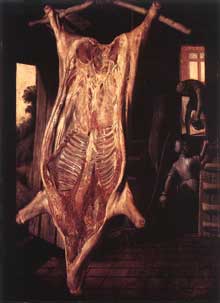Netherlandish, (c.1530-c.1573)

-
The Slaughtered Pig
- (1563), oil on oak
- 44.9 x 32.7 in. (114 x 83 cm.)
- Wallraf-Richartz Museum, Cologne
-
Editor’s Note:
Beuckelaer’s specialties were small genre scenes and large still lifes on panels displaying abundant food, while the background nearly always contained scenes that are depictions of Bible stories.
Beuckelaer also followed his uncle, Pieter Aertsen, in his preference for scenes in which a religious subject is relegated to the background by the still life or genre content. The paintings often had a moralizing purpose, illustrating the opposition between worldly and spiritual values and warning of the pleasures of the flesh.
The theme here of the slaughtered pig and the tradition of the painting Netherlandish butchers’ shops is believed to have a religious significance, as an allegory of the Crucifixion and the Eucharist, represented respectively by the pig in the foreground and the wine being brought from the cellar in the background.
About the Artist
Joachim Beuckelaer, Netherlandish, (c.1530-c.1573). Beuckelaer studied with his uncle, Pieter Aertsen (1508 – 1575), who pioneered the subjects of Flemish kitchen and market scenes. From here, Beuckelaer took up this same early style of still life painting.
